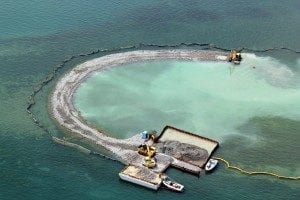Frog Island Wetland Habitat Restoration
Summary

The New York Power Authority (NYPA) has restored two acres of lost fish and wildlife habitat within the middle of the resource-starved Upper Niagara River, with its Frog Island Wetland Habitat Restoration Project, adding a key element that did not exist before: protection against the loss of this restored habitat. To achieve these goals, NYPA overcame especially challenging design and construction considerations, including the inherent high energy river environment, varying water levels, adverse weather conditions, a severely limited construction window, and the presence of the project within surrounding valuable habitat that could not be compromised. This was further complicated by additional competing constraints such as seasonal limitations for fish spawning, visibility to boaters, and the need for a modest appearance. These many variables were addressed with the aid of extensive stakeholder collaboration.
Background and Challenge
By 1985, the once-productive Frog Island area had been reduced to approximately 4.3 acres of largely un-vegetated shallows, and was no longer even visible in aerial photos. Contrarily, deeper waters surrounding this area featured dense beds of aquatic vegetation with high habitat and resource value for fish and waterbirds – scarce features in the highly industrialized Buffalo-Niagara corridor.
This degraded condition was attributed to many powerful erosive forces in the river, as well as to historic human-induced damage from decades of intermittent dredge spoil disposal and gravel mining. While the dredge spoil and mining activities are long discontinued, their impacts remain, and significant natural and human-induced erosive forces continue. The area is frequently subject to storm surges, wind-induced waves, boat wakes and ice scour. Returning Frog Island to its once ecologically productive, marsh-like conditions required that these erosive and other forces be permanently addressed.
Additionally, the project also could not compromise the surrounding deeper and valuably productive areas around it, nor impose a new hazard to boaters or a heavily armored appearance.
Innovation
To restore marshland habitat, two acres of the barren area were excavated to achieve varying depths, and their substrates enhanced with the addition of coarser materials, to sustain a variety of newly planted native emergent and submerged aquatic vegetation. Varying the depths provides sloped surfaces that allows plants (carefully selected for their sustained success in comparable reference marsh areas) to find their preferred depths and to thereby continuously adjust to seasonal and yearly variances in water levels. For wave and ice scour protection, a low-profile stone berm was built to enclose three sides of the newly planted area (the downstream side remains open), sitting largely within the former barren area footprint to avoid unnecessary damage to existing productive areas. In order to make up for the loss of protection that a higher, more massive (and formidable appearing) berm could provide, “plunge pools” were included on the insides of the berm at key areas to dissipate wave energy, and large boulders were embedded on the outsides of the berm to shield them from ice scour damage. Finally, the berm was augmented with raised planting beds, and hummocks were installed within the interior marsh to further soften the aesthetics and improve visibility.
Results
One major project goal, the stability and robustness of the berm, was successfully demonstrated before the dredging/excavation component of the project was even completed. A 50-year storm occurred in November 2013 when the berm had been mostly built, and it survived with no visible or measurable degradation or impact. The partially completed grading inside the berm also fared well and was not affected. The storm was severe enough to damage lesser structures along the river, however, the berm and the inside habitat features passed their first and likely one of its most severe tests. Also, the winter of 2013-2014 was one of the most severe in recent history in terms of ice buildup and, again, the nearly completed berm and inside habitat features proved to be unaffected.
Biologically, despite the project not being complete and before much vegetation had even been planted, a bird species that is rarely seen in the area, the Caspian tern (Hydroprogne caspia), began to colonize, at least temporarily, in significant numbers on some above-water portions of the berm. A few Common tern (Sterna hirundo), a New York State threatened species, were also observed.
Stakeholder Quotes
Paul Leuchner, a former Commissioner of the Niagara River Greenway Commission, praised NYPA for its “grass roots” collaboration model for the project, emphasizing how “…The end result is a quality project that maximizes the ecological benefit to the Niagara River and serves as a catalyst for eco-tourism within the Niagara River Greenway.”
Mike Clancy, a Regional Fisheries Manager for the New York State Department of Environmental Conservation, noted how the project “…benefits fish and wildlife by creating much needed critical spawning and nesting habitat. I was fortunate to observe many rare shore birds using the Island on a recent site visit.”


